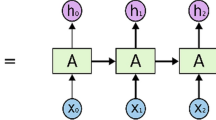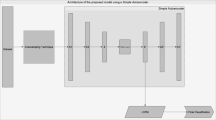Abstract
Credit card fraud detection over the years remains a major concern for all and this has made the field to receive huge attention from researchers. One way of addressing this concern is for financial sectors and government agencies to reliably detect fraud in any transaction so as to prevent financial losses incurred by these sectors and card owners. Exiting fraud detection system is plagued with misclassification and high false-positive rate. To prevent misclassification, this research therefore aims to deploy Long Short Term Memory-Recurrent Neural Network (LSTM-RNN) for classifying financial transaction as fraudulent or not. The system extracted desired features from two different dataset gotten from kaggle repository using Principal Component Analysis and preprocessed using Arbitrary Assignment Method and Min–Max scalar algorithm for Normalization. The work was implemented using python programming language. The relevant features selected were then fed into the LSTM-RNN for classification. The results obtained were compared with past work and our fraud model recorded high classification accuracy as well as reduced false alarm rate. It has 99.58% Prediction Accuracy, 99.6% Precision, and Recall of 80%. The system will enable financial institutions and government agencies involved in financial transaction to detect the occurrence of fraud and be able to proffer the necessary solution as appropriate.
Access this chapter
Tax calculation will be finalised at checkout
Purchases are for personal use only
Similar content being viewed by others
References
Aggelis, V. (2006). Offline Internet Banking Fraud Detection. In Proceeding of the first International Conference on Availability, Reliability and Security, Vienna, Austria, 2006 pp. 904–905. Doi: https://doi.org/10.1109/ARES.2006.89
Anderson, R., Barton, C., Bohme, R., Clayton, R., Van Eeten, M. J., Levi, M., Moore, T., & Savage, S. (2013). Measuring the cost of cybercrime. In R. Böhme (Ed.), The economics of information security and privacy (pp. 265–300). Springer. https://doi.org/10.1007/978-3-642-39498-0_12.
Akhilomen, J. (2013). Data mining application for cyber credit-card fraud detection system. In: Perner P. (Eds.), Advances in data mining, application and theoretical aspects. ICDM 2013. Lectures notes in computer science (Vol. 7987, pp. 218–228). Springer. https://doi.org/10.1007/978-3-642-39736-3_17
Vlasselaer, V. V., Bravo, C., Caelen O., Eliassi-Rad, T., Akoglu, l., Snoeck, M., & Baesens, B. (2015). APATE: a novel approach for automated credit card transaction fraud detection using network-based extensions. Decision Support Systems (75), 38–48.550. https://doi.org/10.1016/j.dss.2015.04.013. ISSN 0167-9236. (Elsevier).
Mishra, S. P., & Kumari P., (2019). Analysis of techniques for credit card fraud detection: a data mining perspective. In: Patnaik S., Ip A., Tavana M., Jain V. (Eds.), New paradigm in decision science and management. advances in intelligent systems and computing (Vol. 1005, pp 89–98). Springer.
Wetson, D. J., Hand, D. J., Adams, N. M., Whitrow C., & Jusczak P. (2008). Plastic card fraud detection using peer group analysis. Advances in Data Analysis and Classification (ADAC, 2008) 2(1), 45–62. https://doi.org/10.1007/s11634-008-0021-8.
Nor Haizan, M., Mohd, N. S., & Abdul H. O. (2012). A Comparative study of reduced error prunning method in decision tree algorithms. In Proceeding of 2012 IEEE International Conference on Control System, Computing and Engineering, Penang (pp. 392–397). https://doi.org/10.1109/ICCSCE.2012.6487177.
Chongxuan, L., Kun X., Jun Z., & Bo Z. (2015). Triple generative adversarial networks. Journal of Latex Class Files, 14(8), 1–16.
Philip, K. C., Wei, F., Andreas, L. P., & Salvatore, J. S. (1999). Distributed data mining in credit card fraud detection. Proceeding of IEEE Intelligent Systems and Their Applications, 14(6), 67–74. https://doi.org/10.1109/5254.809570.
Oyelami, L. O., Adebiyi, S. O., & Adekunle, B. S. (2020). Electronic payment adoption and consumers’ spending growth: emperical evidence from Nigeria. Future Business Journal 6(2020), 1–14. https://doi.org/10.1186/s43093-020-00022-z. (Article number 14)
Xin, T., & Xiaofang, B., (2015). Online Banking Security Analysis based on STRIDE Threat Model. Journal of Decision Support Systems archive, 74(C), 78–87.
Mishra, S., & Thakur A. (2018). A survey on mobile security issues. In Proceeding of International Conference on Recent Advances in Interdisciplinary Trends in Engineering & Applications, pp. 1–10. Available at https://doi.org/10.2139/ssrn.3372207. SSRN-id3372207. (Elsevier).
Singh, G., Gupta, R., Rastogi, A., Chandel, M. D. S., & Riyaz, A., (2012). A machine learning approach for detection of fraud based on SVM. International Journal of Scientific Engineering and Technology, 194–198. ISSN: 2277-1581.
Kirkos, E., Spathis, C., & Manolopoulos, Y. (2007). financial data mining techniques for the detection of fraudulent financial statements. In Expert Systems with Applications, 32 (2007), 995–1003. https://doi.org/10.1016/j.eswa.2006.02.016. (Elsevier).
Osho, O., Musa, F. A., Misra, S., Uduimoh, A. A., Adewunmi, A., & Ahuja, R. (2019). AbsoluteSecure: A tri-layered data security system. In International Conference on Information and Software Technologies (pp. 243–255). Cham: Springer.
Dhawale, C. A., Misra, S., Jambhekar, N. D., & Thakur, S. U. (2016). Mobile computing security threats and solution. International Journal of Pharmacy Technology, 8, 23075–23086.
Khan, R., Malcolm, C., Andrew, C., & George Mohay. (2010). Transaction mining for fraud detection in ERP Systems. Industrial Engineering and Management Systems, 9(2), 141–156. https://doi.org/10.7232/iems.2010.9.2.141.
Boulmaiz, T., Guermoui, M., & Boutaghane, H. (2020). Impact of training data size on the LSTM performances for rainfall-runoff modeling. Modeling Earth Systems and Environment, 6, 2153–2164. https://doi.org/10.1007/s40808-020-00830-w.
Abayomi-Alli, A., Odusami, M. O., Abayomi-Alli, O., Misra, S., & Ibeh, G. F. (2019). Long short-term memory model for time series prediction and forecast of solar radiation and other weather parameters. In Proceedings of International Conference on Computational Science and its Applications (ICCSA), Saint Petersburg, Russia (pp. 82–92). https://doi.org/10.1109/ICCSA.2019.00004.
Yoshihiro, A., Hidehito, G., & Hidehiko, T. (2016). Detecting fraudulent behaviour using recurrent neural networks. In Proceeding of Computer Security Symposium (pp. 805–810), October 11–13, 2016.
Oluwafolake, A., & Akinola, S. O. (2017). A multi-algorithm data mining classification approach for bank fraudulent transactions. African Journal of Mathematics and Computer Science Research, 10(1), 5–13. ISSN 2006-9731.
Behera, R. K, Jena, M., Rath, S. K., & Misra, S. (2020). Co-LSTM: Convolutional LSTM model for sentiment analysis in social Big Data. Information Processing and Management, 58(2021), 102435. (Elsevier).
Apapan, P., & Liu, Y. (2018). Credit card fraud detection using deep learning based on auto-encoder and restricted boltzmann machine. International Journal of Advanced Computer Science and Applications, 9(1), 18–25.
Wu, S., & Banzhaf, W. (2008). Combating financial fraud: A co-evolutionary anomaly detection approach. In M. Keijzer et al. (Eds.), Proceeding of the 10th Genetic and Evolutionary Computation Conference (GECCO-08), Atlanta, USA, ACM, New York (pp. 1673–1680)
Agrawal, A., Kumar S., & Mishra, A. K. (2015). A novel approach for credit card fraud detection. In Proceeding of 2015 2nd International Conference on Computing for Sustainable Global Development (INDIACom), New Delhi (pp. 8–11). IEEE.
Yue, D., Wu, X., Wang, Y., Li, Y., & Chu, C. (2007). A review of data mining-based financial fraud detection research. In Proceeding of 2007 International Conference on Wireless Communications, Networking and Mobile Computing, Shanghai (pp. 5519–5522). IEEE. https://doi.org/10.1109/WICOM.2007.1352.
Throckmorton, C. S., Mohan, V., William, J. M., & Leslie, C. (2015). Financial fraud detection using vocal, linguistic and financial cues. Decision Support Systems, 74, 78–87. https://doi.org/10.1016/j.dss.2015.04.006. ISSN 0167-9236. (Elsevier).
Rustam, F. H., Alexander, K. & Polina, R. (2018). The Difference between precision-recall and ROC Curves for evaluating the performance of credit card fraud detection models. In Proceedings of 9th International Conference on Applied Innovation in IT (Vol. 6, issue 1, pp. 17–22). https://doi.org/10.13142/kt10006.13.
Yazici, Y. (2020). Approaches to Fraud detection on credit card transactions using artificial intelligence methods. Journal of Computer Science & Information Technology (CS & IT), 235–244. https://doi.org/10.5121/csit.2020.101018.
Osho, O., Mohammed, U. L., Nimzing, N. N., Uduimoh, A. A., & Misra, S. (2019). Forensic analysis of mobile banking Apps. In International Conference on Computational Science and Its Applications (pp. 613–626). Cham: Springer.
Jatuphum, J., Ngamnij, A., Somjit, A., & Saiyan, S. (2014). Symbolic data conversion method using the knowledge-based extraction in anomaly intrusion detection system. Journal of Theoretical and Applied Information Technology, 65(3), 695–701 (31st July 2014). E-ISSN 1817-3195
Author information
Authors and Affiliations
Corresponding author
Editor information
Editors and Affiliations
Rights and permissions
Copyright information
© 2021 The Author(s), under exclusive license to Springer Nature Switzerland AG
About this chapter
Cite this chapter
Owolafe, O., Ogunrinde, O.B., Thompson, A.FB. (2021). A Long Short Term Memory Model for Credit Card Fraud Detection. In: Misra, S., Kumar Tyagi, A. (eds) Artificial Intelligence for Cyber Security: Methods, Issues and Possible Horizons or Opportunities. Studies in Computational Intelligence, vol 972. Springer, Cham. https://doi.org/10.1007/978-3-030-72236-4_15
Download citation
DOI: https://doi.org/10.1007/978-3-030-72236-4_15
Published:
Publisher Name: Springer, Cham
Print ISBN: 978-3-030-72235-7
Online ISBN: 978-3-030-72236-4
eBook Packages: Intelligent Technologies and RoboticsIntelligent Technologies and Robotics (R0)




